From Floridata
by
Steve Christman
Prunus angustifolia
Common
Name: Chickasaw plum
Botanical
Family: Rosaceae, the rose Family
Description
Chickasaw
plum is usually a shrub with a short (sometimes multi-stemmed) trunk
and numerous slender branches. It normally grows to 6-12 ft (2-3 m) in
height, but can become a small tree up to 25 ft (7.5 m) tall. Like
other plums, this one is armed with lateral twigs that end in sharp
spines. The bark is dark and not exfoliating as in the similar American
plum (Prunus americana). Chickasaw plum characteristically forms dense thickets, unlike the very similar flatwoods plum (P. umbellata)
which usually grows with a single trunk. The leaves of Chickasaw plum
have teeth that are tipped with little red or yellow glands. (You need
a hand lens to see these.) Leaves of flatwoods plum and American plum
lack the glands.
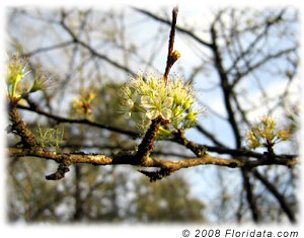
The Chickasaw plum covers itself in small
white blossoms in late winter and early spring.
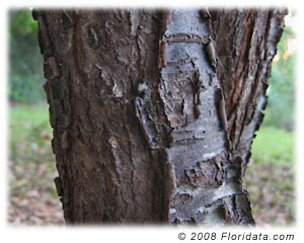
Chickasaw plum bark
The
flowers of Chickasaw plum come out before the leaves in late winter or
very early spring on the previous year's wood. They are white with a
mild fragrance and less than a half inch (1.25 cm) across, but they
cover the entire bush with a spectacular show when almost nothing else
is blooming. As they age and begin to fall off, the flower parts become
brownish, giving the shrub a muddy brown appearance from a distance
that lasts for a couple days. Chickasaw plum fruits are oval in shape,
usually red, and quite tart to the taste.
Prunus angustifolia
is native to much of the United States from Pennsylvania west to
Colorado, and south to Texas and Florida. It favors old fields, waste
places, old home sites, roadsides and fence rows, but also occurs in
dry sandy soils within scrub, sandhill and dry woodland communities.

The Chickasaw plum leaves are narrower and more finely toothed than those of the wild plum (P. americana).
Culture
Chickasaw
plum is easy to grow in almost any soil except strongly alkaline. Mow
or prune unwanted suckers and seedlings that appear around the base of
the plant, or let it form an attractive thicket that will be welcomed
by butterflies, song birds and other wildlife.
Light: Like other plums and cherries, Chickasaw plum does best in full sun, but hangs in there in partial shade.
Moisture: Established Chickasaw plums are drought tolerant.
Hardiness: USDA Zones 5 - 9.
Propagation: Fresh
seeds should be kept warm for a couple months, then chilled for 2-4
months before planting. They may take two years to germinate. Cuttings
are difficult to root. Use young, fast growing, soft wooded tips under
mist with bottom heat.
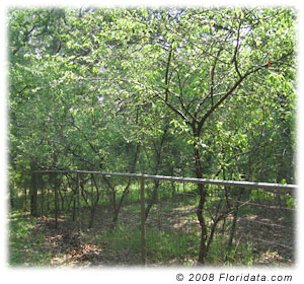
The owner of this clump of Chickasaw plums keeps the space mowed between selected tree trunks to form a neat grove.
Usage
In
early spring, before most shrubs and trees have even started to leaf
out, the Chickasaw plums are in full bloom - billowing white clouds
along southern highways. This is a handsome little shrub, perfect for
the semi shaded woodland area in the back of the yard. They grow
naturally in dry, sandy soils and, once established, need no
supplemental watering. The fruits, although tart, are used to make
jelly by folks in the know, and eaten fresh by animals in the know. The
flowers will attract native insects and the plums will attract native
wildlife. The original Americans ate the plums and dried them for
keeping. Chickasaw plum, with its attractive bark, small leaves and
slender branches, has been used for bonsai.
Features
Chickasaw
plum should be a part of any native (to the U.S.) landscape planting.
They are maintenance free, produce a beautiful flower show, and attract
wildlife.
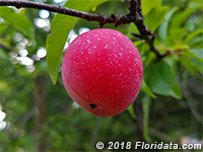
| 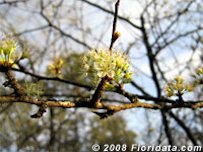
| | A ripe Chickasaw plum | Chickasaw Plum Blossoms |
|
|